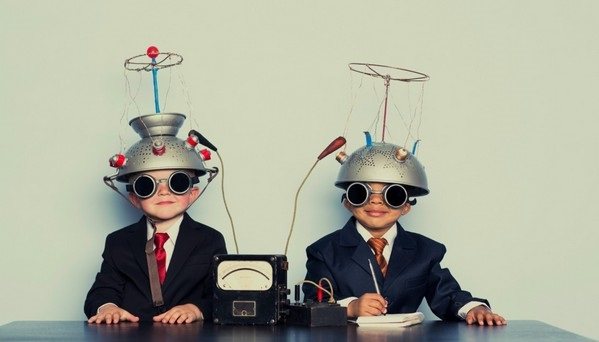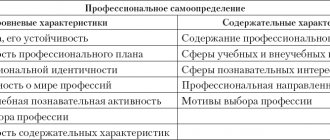- July 29, 2019
- Psychology of Personality
- Denis Dmitriev
Intelligence is considered to be one of the most important qualities of any individual. However, recognition of its unconditional value does not mean that everyone knows exactly the correct definition of this concept. In a general sense, when answering the question of what human intelligence is, several options can be given.
The official popular scientific definition states that these are generalized abilities to understand, cognition, solve problems and get out of difficult situations. This term combines many cognitive parameters of each individual, including imagination, thinking, perception, memory, representation and sensation.
Options for defining the term “intelligence”
The modern variation can be interpreted in a slightly different way. Human intelligence in this case is presented as the ability for an individual to plan, organize and control his own actions in order to achieve a goal, as well as taking into account the coincidence of its truth and good actions. The only opportunity for the development of this quality is being in the information space, which is formed when engaging in various types of activities throughout life. Education and application are built through the use of the principles of the organization of intelligence. That is, in essence, the definitions of information space and intellectual space are identical. In both cases, planning principles are applied, as well as control of each stage on the way to completing a number of tasks and achieving some set goal.
On the other hand, Academician N.N. Moiseev also conducted a study on what human intelligence is, resulting in a different definition of this term. According to him, this term means, first of all, goal setting, the ability to plan resources and build a clear strategy for forming a path to achieving the goal set by the individual. The modern definition of intelligence is usually interpreted as the ability to carry out the process of cognition and solve problems as efficiently as possible, for example, when a person is just mastering a new range of life tasks. In this regard, it is possible to fabricate that this quality of an individual is susceptible to both progress and regression over time. In addition, its final level will depend on the area in which a person applies his abilities.

Genius
In some cases, when a person exhibits high intellectual activity in creative activity, it may be accompanied by what, based on certain characteristics, is perceived as genius.
If we understand the meaning of the mechanisms that form the basis of the psyche and determine intellectual potential, as well as the essence of this potential itself, we can talk about an extreme state of intellectual creativity, i.e. about genius. As a rule, genius is the degree of intellectual potential that contributes to the creation of extraordinary and particularly outstanding creative results.
The state of genius is distinguished by its characteristics of mental as well as physiological organization. And these characteristics are such that without painstaking and quite serious work, you simply shouldn’t expect any brilliant ideas and results. Among these characteristics are:
- The required level of energy and energy, depending, among other things, on the characteristics of blood movement through the vessels, metabolism and ventilation of the lungs. If they do not meet certain parameters, the human body will not have the opportunity to fully develop creative skills.
- Regardless of the level of energy and energy, a person must have a motivating force - something that will constantly push him to action and force him to stick to the chosen direction. Otherwise, a person will not even lift a finger, because he will not have any goal.
If these two characteristics are present, and their combination turns out to be suitable, a person becomes dissatisfied with the current state of affairs, which requires conscious volitional efforts to change. And when the understanding of a particular situation accumulates and reaches a critical point, that same insight occurs, called genius. If a person lies on the couch and looks at the ceiling, he better not count on any revelations.
What is genius? First of all, this is a constant stay in the process of comprehending some creative idea, incessant brain activity that prevails over everything else. It does not stop even when a person is sleeping, because it is of such great importance to him that it receives nourishment from most existing areas of perception.
This activity does not appear on its own or out of nowhere. This is a consequence of painstaking study and thinking about a certain problem or situation that plays the most important, almost the main role in a person’s life (one of such situations may be a state of love, when it is impossible to think about anything else).
The conclusion follows from this: in order to do truly brilliant things, it is not at all necessary to be a natural genius or to inherit some genetic traits from your ancestors. The state of genius can be achieved artificially by “getting sick” with something completely and irrevocably. This “disease” activates maximum intellectual potential, thereby leading to a state of creative genius.
We are deeply convinced that every person should develop thinking and intelligence. This should not be influenced by the environment, circumstances, or any other reasons. The only thing that should have an impact is a sincere desire to develop, become better and smarter. We wish you to have this desire, never stop at anything and, of course, collect as much information as possible about the work of intelligence and its features.
Let our article serve as another coin to your knowledge bank. We sincerely wish you good luck and achieving new heights!
We also recommend reading:
- Storytelling
- Gardner's Theory of Multiple Intelligences
- What You May Not Know About Intelligence
- To develop or to degrade?
- Several techniques of the art of thinking effectively from the book “Phenomenal Intelligence” by K. Sheremetyev
- IQ: what is it and how is it measured?
- Cattell-Horn-Carroll theory
- How to become smarter: 4 types of intelligence according to Stephen Covey
- General Intelligence Factor
- Intelligence and its development: several recommendations
- What models of intelligence exist?
Key words: 1LLL, 1Cognitive science
Characteristics of intelligence and related abilities
The developed thinking of Homo sapiens allowed him to separate from the rest of the animal world and take a dominant position on the entire planet. It is worth noting that the influence of a person’s intelligence absolutely extends beyond his own life, that is, it has a posthumous influence on the existence of future generations. Of course, this quality must be equally combined with other abilities of the individual, otherwise it will not have such significant significance, for example, without the skills of cognition, learning and logical thinking. It is also required to be able to analyze information for its subsequent systematization, classify the applicability of data in various respects, find certain connections, differences, and patterns, as well as associate the information received with any other and similar ones.
In total, we can distinguish seven main parameters by which the level of intelligence development of a particular person can be characterized.
- Breadth of thinking. It refers to the ability of an individual to cover the issue under consideration completely without losing the original input data about it. This parameter also includes the ability to see the variability of the solution to a specific task.
- Curiosity. A person’s desire for a comprehensive knowledge of a particular phenomenon he is studying in certain essential respects. Without the development of this quality, any cognitive activity in itself becomes difficult.
- Critical thinking. A necessary skill for strictly assessing the results of one’s own intellectual activity. It is expressed in the ability to subject one’s judgments to critical evaluation, discard wrong decisions, and stop performing unnecessary actions if they are inconsistent with the task at hand.
- Depth of mind. The main purpose of this characteristic is the ability to separate the main from the secondary, significant from everything else, and also to distinguish between the concepts of necessary and accidental.
- Evidence of thinking. A fairly significant trait, thanks to which a person is able to find the right facts, patterns and arguments at the right moment that could convince other people of the correctness of the individual’s conclusions and judgments.
- Logical thinking. The ability to arrange all facts and judgments in a certain strict sequence, take into account all aspects and characteristics of the object under consideration, and trace every possible relationship.
- Mobility and flexibility of the mind. The ability to make the widest use of existing experience, operational research and establishment of connections and relationships between new subjects, as well as the ability to overcome stereotyped and stereotyped thinking.

Intelligence and creativity – friends or enemies?
I wonder if intelligence and creativity go together? Do you think you need a good IQ to come up with something great? Or, in fact, is too high an IQ a barrier to creativity? Experts in this field have asked similar questions. What conclusions did they come to? The results were surprising.

What does it mean to be creative?
A feature of creative (creative) thinking is the ability to come up with new things. Ideas, formulations, hypotheses, definitions, images that no one has used in this configuration. Thoughts that break out of established patterns and move the field further. Despite the fact that creativity is most often associated with science and art, it can be reflected in business, politics, pedagogy, and philosophy. There is a misconception (and a widespread one) that creativity is manifested by revolutionary discoveries. This is wrong. It is enough to create things that are new for a particular person, overcoming his horizons and mental stereotypes.
Levels of Creativity
Experts distinguish several types of creativity. The most interesting division of creativity according to the degree of “discovery” or “novelty”:
- expressive (spontaneous) type - ideas arise spontaneously, from a sudden stimulus or strong desire;
- innovative - a novelty related to a thing of widespread use, with the intention of doing something unusual;
- Inventive – a very original advantage that offers a completely new solution;
- emergent is a sign of genius.
Imagery and functionality
Another important theoretical conclusion regarding creativity is the fact that things that arise in the process of creativity must have 2 characteristics. First of all, they must be of immediate utility. In order for something new to become truly new, it must benefit someone (material, aesthetic, etc.).
There are also cases of original inventions whose usefulness is more than controversial (for example, instruments of torture). Experts use the term anti-creativity in cases where original ideas are directed against society.

Creativity as part of any intelligence
Knowing how modern psychology understands creativity, we can finally begin to wonder how it relates to the combination of “intelligence + creativity.” Maybe a little different than everyone tends to think. IQ is a general measure of a person's ability to interpret information received and develop a solution to a problem. One part of this defined intelligence is associated with the ability to study concepts, procedures, and patterns. A person learns these basics from early childhood in the family, then in elementary school.
At the same time, it is important to learn to apply these formulations to new situations. This creates a point of contact between intelligence and creativity. For example, if you say: 2 + 2 = 4, your intellect should come to the conclusion that 4 + 4 = 8 (twice the original answer). This example clearly shows the relationship between IQ and creativity.
Intelligence as a tool for choosing the right solution
However, there are situations where the relationship between creativity and intelligence is exactly the opposite. Imagine that you have to complete a certain creative task. Imagination feeds you with many ideas, which in itself is good. But how can you choose the right solution from a large number of proposals or ideas? In this case, nothing can be done about creativity itself; one must call on the mind to help, because An important aspect of intelligence is the ability to filter decisions effectively.
A similar relationship also applies between the availability of information and the ability to use it appropriately. A person can have excellent skills in obtaining information from various sources, fortunately, today offers a huge amount of them. But in the absence of a sufficiently developed part of the brain responsible for thinking abilities, he will not be able to select from the quantum of data what is suitable for solving a particular problem. Therefore, it is possible to get a positive result, but it will take too much time. People with high IQ are characterized by the ability to quickly and accurately select the right decision through their own thinking.
High IQ does not mean creativity
Scientific research has not demonstrated a direct link between IQ and creativity. Some sources even indicate that high intelligence can be detrimental to certain types of creative activities. This fact is well illustrated, for example, by the case of one of the most influential artists of the 20th century, Andy Warhol. Although many would not hesitate to classify this man as an artistic genius, his IQ reached a rather mediocre level of 86. So if your IQ is far from satisfactory, do not despair. No matter what, you can achieve a lot.

Intelligence Structure and G Factor
It is known that this quality functions in combination with a whole complex of personality traits of an individual. However, there is still no consensus among scientists and psychologists on its structure and understanding of what human intelligence is. However, the problem does not lie in the insufficient degree of study of this phenomenon. In simple terms, we can say that intelligence varies. That is, for example, between a writer and a mathematician, his level may differ not only quantitatively, but also qualitatively, which is undoubtedly more important.
In a general sense, there is a single accepted term of intelligence in the context of a person’s primary mental abilities. This definition is called factor G, that is, the main general factor. According to him, the intellectual level of an individual is measured in the speed of processing information flows, the ability to quickly assimilate new knowledge, carry out conscious comprehension of it, establish relationships and associations with previous experience, and also remember existing information for long periods of time. In addition, there are a number of minor factors.
Primary mental abilities
These abilities constitute the fundamental elements of intelligence and all human activity. The number of such primary mental abilities is quite large. For example, the famous intelligence researcher J. Guilford discovered 120 such elementary factors, thanks to the development of which the quality of mental activity of any individual increases.
Some primary mental abilities can be divided into a number of categories, listed below.
- Ability to perform mental operations. Includes analysis, synthesis and comparison of objects and phenomena. This also includes the creation of complex mental structures and the ability to draw competent conclusions.
- Verbal abilities. They determine the possibilities of understanding speech and using speech units both in the course of their own inventions and reasoning, and for communication with other people.
- Memory. It implies the maximum volumes of stored information, the speed of assimilation and long-term memorization, as well as the duration of its availability for use at any time.
- Ability to perform basic arithmetic operations, oral and written calculations in an acceptable time frame.
- The ability to navigate in space, as well as visually determine the sizes, volumes and shapes of various objects.
The combination of these abilities implies the presence of a certain intellectual level of development of the individual. Nevertheless, it is worth noting that all of the above primary characteristics are rarely developed to an equally high degree, which is undoubtedly influenced to a certain extent by the hereditary factor.

Functions of intelligence and its origin
We can say that this quality is fundamental in the development of Homo sapiens as a species and the subsequent emergence of civilization. At the dawn of human development, intelligence provided him with the opportunity to survive and leave behind offspring. Individuals with more developed mental abilities had an increased chance of a comfortable existence. The origin of human intelligence is largely determined by the adaptive function. It is known that people who adapted to different environmental conditions survived better than others. Over time, the role of intelligence has changed somewhat due to completely different goals and objectives that modern man sets for himself. This quality today serves for successful self-realization, development of any abilities, earning respect and obtaining high social status. Without a sufficient level of intelligence, it is difficult to imagine quickly developing the skills and mastering new knowledge necessary to achieve success in any field of activity. Characteristics like strength, speed and agility in the current reality have faded into the background and are no longer of paramount importance.
Among scientists who discuss the question of what human intelligence is, the prevailing opinion is that conditionally this quality can be divided according to the degree of expression into three levels.
- Short. With such intelligence, people have weak mental abilities and at the same time cannot sufficiently resist the influence of the environment on their external and internal world. Reality suppresses most of their endeavors, because such individuals are not able to adapt to it. They are often in the care of the rest of the more developed part of society.
- Average. People in this category have a higher level of mental activity, which is enough for them to live comfortably and be able to adapt to various circumstances. Good thinking skills enable such individuals to find a place in the world that matches their skills and needs.
- Higher. It is believed that people at this level do not simply adapt to the reality around them, but independently change the world around them to suit their own needs and desires. High human intelligence capabilities greatly contribute to the development of creative potential.
It is worth noting that most individuals are at an average level of development, which is most likely dictated by evolutionary considerations.

Intelligence, definition, concept, functions
Page 1 of 5Next ⇒Intelligence, definition, concept, functions
Intelligence is one of the most complex mental abilities of an individual . In understanding its essence, the opinions of psychologists differ. Difficulties arise even in the very definition of intelligence. Here are some of the definitions:
1) Intelligence is the ability to think. 2) Intelligence is a type of adaptive behavior aimed at achieving a goal. 3) Intelligence is a holistic characteristic of human cognitive processes. A generalized definition might look like this: Intelligence
(from Latin
intellectus
- cognition, understanding) is a generalized cognitive formation, which includes: perception, memory, attention, imagination, representation. It also has properties that are not detected when studying individual cognitive processes, but are generalized manifestations of the entire cognitive sphere of the individual. Intelligence, in addition, depends on the personal characteristics of the subject.
Intelligence functions:
1. Ability to perceive information; 2. Ability to generalize information; 3. Ability to analyze information; 4. Ability to synthesize information; 5. Ability to predict changes in information; 6. The ability to change ( adapt ) these abilities;
Types of intellectual disabilities.
In clinical psychiatry, it is customary to distinguish two main forms of intellectual impairment: mental retardation (oligophrenia) as a type of dysontogenesis and dementia. With oligophrenia there is no increase in intellectual defect. Dementia is the decay of more or less formed intellectual functions.
Mental retardation is a set of etiologically different, hereditary, congenital or early acquired, persistent, non-progressive syndromes of general mental retardation, manifested in difficulty in social adaptation, mainly due to a predominant intellectual defect.
Classification of mental retardation in ICD-10:
1. Mild mental retardation - F70
2. Moderate mental retardation – F71
3. Severe mental retardation – F72
4. Severe mental retardation – F73.
Dementia is an impoverishment of mental activity, with intellectual degradation, decreased volitional activity, emotional emaciation, and a decrease in the group of interests and previously inherent individual traits.
Signs and symptoms
Dementia affects people differently, depending on the impact of the disease and the individual's characteristics before becoming ill. Signs and symptoms associated with dementia progress through three stages.
Early stage: Early stage dementia often goes undetected as it develops gradually. Common symptoms include: forgetfulness; loss of track of time; disorientation in familiar areas.
Middle stage: As dementia progresses to the middle stage, signs and symptoms become more obvious and increasingly limiting. These include: forgetfulness of recent events and people's names; disruption of home orientation; increasing difficulties in communication; need for help with self-care; behavioral difficulties, including walking aimlessly and asking the same questions.
Late stage: In the late stage of dementia, almost complete dependence and passivity develops. Memory impairment becomes significant and physical signs and symptoms become more obvious. Symptoms include: loss of orientation in time and space; difficulty recognizing relatives and friends; increasing need for help with self-care; difficulties in movement; behavioral changes that may escalate and include aggression.
Mental retardation, concept, types
Mental retardation is a set of etiologically different, hereditary, congenital or early acquired, persistent, non-progressive syndromes of general mental retardation, manifested in difficulty in social adaptation, mainly due to a predominant intellectual defect.
Kinds:
· Practical (helps in everyday life)
· Conceptual (woe o tuma)
· Social
Classifications of intellectual disability
Esquerolle:
· According to the severity of the intellectual defect
· According to the degree of expression of speech
Etiogenetic
Etiopathogenetic is a classification created for the purpose of social pedagogical prognosis; they divide mental retardation based on learning ability and social adaptation.
According to the characteristics of emotional manifestation
Based on clinical and biological signs
First classification of mental retardation according to Philip Pinnel
1. A state close to an animal, characterized by complete savagery, absence of all feelings, including physical needs;
2. A condition in which there are some concepts and physical needs;
3. Stupidity is a state in which there is some degree of reason and speech;
4. Imebecilism is a condition in which the subject experiences a gradual deterioration of the intelligence that once existed.
The first classification according to the degree of expression of intellectual intelligence distinguishes 3 groups.
According to Esquirol:
idiocy is a congenital condition,
mental retardation - acquired,
Imbecility can be both congenital and acquired.
Esquirol also systematized the weak-minded on the basis of one of their leading symptoms - the degree of speech development:
Imbeciles of the 1st degree (having free and understandable speech);
2nd degree (those who have understandable speech and a limited vocabulary);
Idiots of the 1st degree (using short words and phrases);
Idiots of the 2nd degree (using only monosyllabic words and shouts);
Idiots of the 3rd degree (not having speech).
Mental retardation of teratogenic origin
Mental retardation associated with brain injury
Reduced intelligence in Down syndrome.
Down syndrome (trisomy of chromosome 21) is one of the forms of genomic pathology in which the karyotype is most often represented by 47 chromosomes instead of the normal 46, since chromosomes of the 21st pair, instead of the normal two, are represented by three copies.
The English physician John Langdon Down was the first to describe and characterize the syndrome, later named after him, 1862
Down syndrome is not a rare pathology - on average there is one case in 700 births . In both sexes, the anomaly occurs with equal frequency.
The age of the mother affects the chances of conceiving a child with Down syndrome. If the mother is from 20 to 24, the probability of this is 1 in 1562, if the mother is from 35 to 39, then 1 in 214, and over the age of 45, the probability is 1 in 19. Although the probability increases with the age of the mother, 80% of children with this syndrome are born to women under 35 years of age. This is explained by the higher birth rate in this age group. According to recent data, paternal age, especially if older than 42 years, also increases the risk of the syndrome.
Down syndrome is a chromosomal pathology characterized by the presence of additional copies of genetic material on chromosome 21, either completely (trisomy) or partially (for example, due to translocation).
Trisomy of the 21st chromosome is the cause of Down syndrome in 95% of cases, and in 88% of cases due to non-disjunction of maternal gametes and in 8% of male gametes.
With mosaicism , nondisjunction occurs in the embryonic cell in the early stages of its development, as a result of which the karyotype disorder affects only some tissues and organs. This variant of the development of Down syndrome is called “mosaic Down syndrome” (46, XX/47, XX, 21). This form of the syndrome is usually milder (depending on the extent of the altered tissues and their location in the body), but is more difficult for prenatal diagnosis. This type of syndrome appears in 1-2% of cases.
Microcephaly. Craniostenosis.
One of the most common anomalies in severe degrees of mental retardation (3-10%). Microcephaly is observed in Down syndrome, Tay-Sachs disease, phenylketonuria and other diseases. The frequency of all cases in the population is 1: 2000. True microcephaly, being a hereditary anomaly, is less common - 1: 25,000.
Clinic.
The syndrome is characterized by a symmetrical reduction of the skull by at least three standard deviations with a normal or slightly reduced face and a flattened forehead. The ears are enlarged, the nose is elongated, squint.
Severe mental retardation (less often mild) is a mandatory sign of the syndrome.
Pathogenesis.
Microcephaly is a disease that has various causes. These may be autosomal recessive genes and polygenic complexes that cause familial microcephaly.
Craniostenosis is the premature fusion of one or all cranial sutures, leading to a limited volume of the cranium, which contributes to increased intracranial pressure. the disease is also characterized by various deformations of the skull. This pathology occurs approximately once in a thousand newborns, and male infants are more often affected.
Craniostenosis is classified into scaphocephaly - fusion of the sagittal suture, leading to an increase in the skull in anteroposterior diameter; brachycephaly - fusion of the coronal and lamboid sutures, characterized by an increase in the transverse diameter of the skull; trigonocephaly - fusion of metopic sutures, which leads to a triangular protrusion of the skull in the forehead.
Etiopathogenesis of Craniostenosis.
The disease is caused by heredity and diseases suffered in utero. The main reason is improper formation of bone tissue during embryonic development. Fusion of the sutures is possible as in the prenatal period - then severe deformation of the skull is observed. and in the postnatal period.
Clinical picture of Craniostenosis.
Patients with craniostenosis experience severe headaches and vomiting. constant nausea, intracranial pressure is significantly increased. Convulsions and exophthalmos are possible. mental retardation, as well as symptoms of meningitis and mental disorders.
Diagnosis of Craniostenosis.
Diagnostic tests such as x-rays and tomography allow an accurate diagnosis to be made in the shortest possible time. Craniostenosis must be differentiated from microcephaly.
Treatment of Craniostenosis.
At an early stage of the disease, surgical operations to increase the volume of the skull are indicated. Timely treatment allows you to completely restore normal brain function and get rid of all the symptoms of the disease.
Thought disorders
Thinking disorders are the first sign of mental retardation.
Reducing the level of generalization. Mentally retarded individuals think concretely, that is, they remain at the mercy of single visual images, unable to understand the general and essential hidden behind them. They remember rather than reflect. They group objects based on secondary characteristics. This type of thinking disorder is also detected by the “four odd one” method.
They don’t understand that the proverb has two meanings. Analysis of problem solving is difficult. When comparing objects, it is easier for retarded subjects to identify differences than to grasp similarities. During the learning process, the weakness of generalizations manifests itself in poor assimilation of rules and general concepts. Children are able to learn the rules by heart, but do not understand the meaning and cannot apply them in practice. Mentally retarded individuals do not know how to abstract from specific details.
Underdevelopment of higher forms of thinking is “the first and most common complication that occurs as a secondary syndrome in mental retardation,” but a complication that does not necessarily arise. Violation of the dynamics of mental activity manifests itself in the form of lability and inertia of thinking
Inertia of thinking, difficulty switching from one thought to another, that is, viscosity, a kind of reasoning, manifests itself in thoroughness and excessive detail.
Violation of the motivational (personal) component of thinking is typical for mentally retarded persons who, as a rule, lack a motive for action. thinking becomes not only superficial and incomplete, but also ceases to be a regulator of behavior.
Diversity of thinking, i.e., the flow of judgments in different channels, is found in some mentally retarded subjects who, when making classifications, use either the properties of objects or personal tastes and attitudes.
Impaired critical thinking (lack of control over one’s actions and correction of mistakes made) is a constant characteristic of mentally retarded subjects who do not know how to evaluate work and weigh the pros and cons.
The weakness of the regulatory role of thinking in individuals with mental underdevelopment arises, in particular, due to the fact that they do not know how to use, if necessary, already acquired mental actions. They rarely notice their mistakes. They don't even consider that their judgments and actions may be wrong.
Speech disorders
Speech disorders in mentally retarded persons are common (40-60%). They manifest themselves in the form of muteness, limited speech to a few words, tongue-tied due to deformation of the speech organs (cleft palate), tongue-tied with impaired hearing, tongue-tied with late development of speech, tongue-tied associated with stuttering or speech lacking expressiveness. With mild mental retardation, there is a significant delay speech development. However, the degree of speech correction depends on training and education.
Motor speech skills and auditory discrimination of sounds appear at 3-4 years.
Underdevelopment of speech may be due to slowly developing and unstable differentiated conditioned connections in the area of the auditory analyzer.
Speech sounds are perceived inseparably.
The formation of phonemic hearing is often disrupted. Already highlighted and familiar words are perceived unclearly. Sounds are poorly distinguished, especially consonants. In this regard, when they pronounce words, some sounds are replaced by others. It also makes it difficult to write words. Due to poor recognition of word endings, the development of grammatical forms suffers. They also have a slow development of articulation - the entire complex of movements of the mouth, throat and vocal muscles necessary to pronounce words.
In mentally retarded children, the first words appear only at 2-3 years, short and ungrammatical phrases - at 5-6 years. Mentally retarded schoolchildren have obvious speech underdevelopment. Their vocabulary is very poor. Active vocabulary is especially poorly formed.
Thus, mildly mentally retarded children acquire basic speech skills with a delay, but most of them acquire the ability to use speech for everyday purposes and carry on a conversation.
Memory disorder.
Basic memory impairments: fragility of storage, inaccuracy of reproduction. They take a long time to learn new things, after many repetitions.
Indirect memory is impaired. Ineffective processing and selection of material to be memorized.
Children cannot identify the essential features of the memorized word.
When children learn, their indirect memorization improves.
Mentally retarded children do not remember material well; they remember the signs of the material better.
The motivational component of memory is impaired. Children cannot purposefully learn and remember. They remember what interests them.
Eidetic memory disorders (reproduction of traces of what is being reproduced). Does not understand and is not able to tell what is in the material.
Logically mediated memorization suffers the most.
Mechanical memory appears to be intact. Memorization is usually mechanical, determined by the external sign of the object.
Feeling disorders
The feelings of mentally retarded children are immature and insufficiently differentiated: subtle shades of feelings are inaccessible to them, they can only experience pleasure and displeasure. Mentally retarded children also differ in the nature of their feelings: some experience all life events superficially, while others are characterized by great inertia of experiences, getting stuck on some insignificant events.
The emotions of a mentally retarded individual are often inadequate. They only value highly those who are pleasant or what gives pleasure.
As the child's personality develops, feelings change.
Weakness of thought inhibits the formation of these higher feelings.
Many mentally retarded people exhibit painful manifestations of feelings: some have weakness with outbursts of irritability; others have dysphoria. In more rare cases, unmotivated elevated mood or apathy, reluctance to move, and loss of childhood interests and affections may be observed.
Volitional disorders
The will of mentally retarded persons is characterized by a lack of initiative, an inability to manage their actions, and an inability to act in accordance with any distant goals. They put off the most urgent matters, such as urgently repairing clothes.
Mentally retarded persons are characterized by lack of independence, lack of initiative, inability to manage their actions, inability to overcome the slightest obstacles, and resist any temptations or influences that are combined with volitional disorders of the opposite type.
mentally retarded persons are suggestible and uncritically accept the instructions and advice of those around them. They can easily be persuaded to offend a loved one or a weak person, break a necessary thing, etc. Along with this, they can show extraordinary stubbornness, senseless resistance to reasonable arguments, and do contrary to what they are asked to do.
These contrasts in the manifestations of the will are an expression of the immaturity of the individual, the underdevelopment of spiritual needs.
The motives for educational, work and other actions of a mentally retarded individual are set by adults, but they do not turn into their own effective motives.
Immaturity of personality, underdevelopment of self-control and rational processing of current external impressions leads to an abundance of impulses of primitive, immediate reactions to external influences. The child grabs the thing he likes without thinking about the consequences.
Lack of independent personal processing of these influences.
The personality of a mentally retarded child is formed on the basis of his assimilation of social forms of consciousness and behavior.
Lack of independence becomes less pronounced over the years, as one gains life and work experience. Hypobulia occurs due to lack of motivation.
Building self-esteem
Self-esteem is formed under the influence of evaluation from others, one’s own activities and one’s own assessment of its results. When a positive assessment in the family collides with a negative one, for example in kindergarten, the child develops resentment, stubbornness, pugnacity, etc. These forms of behavior become personality traits if this situation continues for a long time. Negative personality traits arise in response to the child’s need to avoid severe affective experiences associated with loss of self-confidence.
Underdevelopment of psychomotor skills
Typically, mentally retarded individuals have underdevelopment of psychomotor skills, manifested in a slowdown in the rate of development of motor functions, in unproductiveness and insufficient expediency of successive movements, in motor restlessness and fussiness. Movements are poor, angular, and not smooth enough. Subtle and precise movements, gestures and facial expressions are especially poorly formed.
School performance
Great difficulties are observed in the area of school performance, with particular difficulties in mastering reading and writing. However, it is training that contributes to the development of skills and the identification of compensatory opportunities.
Under favorable circumstances, a mildly mentally retarded teenager is able to master professions that require abilities for practical activities, that is, unskilled and semi-skilled manual labor (painter, mechanic, seamstress, cardboard maker, etc.).
Attention disorders
Everyone's attention is impaired. It is difficult to attract, is unstable and distractible. Extremely weak active attention prevents the achievement of the goal. Under favorable conditions, it can be significantly improved; it is possible to achieve more active inclusion in classes with the teacher, switching in the process of performing the mastered activity.
Thought disorders
Moderately mentally retarded subjects have a very limited supply of information and ideas. They have difficulty operating with existing ideas. Their thinking is concrete, inconsistent, and slow-moving. The development of visual thinking suffers. The formation of abstract concepts is either inaccessible or sharply limited to the most elementary generalizations. They can be taught to group clothes, animals, etc. They can only make distinctions on specific objects. They are not able to operate with abstract concepts. persons do not know how to analyze a subject, apply techniques of comparison, transfer, and targeted search. They are made difficult by establishing connections between individual parts of the task. Because of this, there is a lack of focus, speed and accuracy of reactions, switching from one action to another, and self-control is not developed.
Some moderately mentally retarded children learn all the letters, combine them into syllables and read even short texts. Comprehension of the text read is, as a rule, beyond their capabilities.
Speech disorders
These children slowly, delayed by 3-5 years, develop understanding and use of speech, and its final formation is limited. Speech development usually corresponds to the degree of mental retardation. At the same time, the child understands the interlocutor’s speech very limitedly, satisfactorily capturing intonations, gestures and facial movements. In the future, especially under the influence of teachers, speech develops, but its understanding is ultimately determined by personal experience. Expressive speech is limited to single words or short sentences. The vocabulary is poor, it consists of the most frequently used words and expressions in everyday life. The pronunciation aspect of speech is defective, speech is almost devoid of modulations, there is pronounced tongue-tiedness, disturbances in the structure of many words and agrammatism. In 20% of moderately mentally retarded children, speech does not appear at all, which is associated with damage to the speech areas of the cerebral cortex.
Memory disorders
Memory is not developed enough. Its volume is small, but by adolescence it can increase, reaching the level found in mildly retarded children. Long-term memory improves better than short-term memory. When reproducing captured material, distortion often occurs. Voluntary memorization is impaired. Both logical and mechanical memory suffers. Children with moderate mental retardation according to the correctional school program (8th type) are unteachable. A small part of them, mainly due to their good mechanical memory, master the basic skills necessary for reading, writing and basic calculation. Educational programs (in special classes of correctional schools or boarding schools) can give them the opportunity to develop their limited potential and expand the range of self-service skills and orientation in the immediate environment. Hardly acquired knowledge is usually applied mechanically, like memorized cliches. As a result of training through repeated visual demonstrations with gradual complication of the task over several years, it is possible to prepare adolescents for work and life in a work community. In addition to labor lessons, it is necessary to strengthen reading and numeracy skills related to labor processes. The introduction of social adaptation lessons that reproduce the most common life situations facilitates their habilitation (Gaubrikh N. Yu., Kuzmitskaya M. I., 1975). Moderately mentally retarded adults who are calm and amenable to guidance are usually capable of simple practical work with careful construction of tasks, constant supervision and instructions from an instructor. Independent work is not available to them.
Attention disorders
Attention is always seriously impaired: sometimes it is not attracted at all, and if this can be done, then it is unstable. Active attention may be absent. At a younger age, it is sometimes possible to attract the attention of some children, but only with bright objects, and even then for a very short time.
Feeling disorders
Severely mentally retarded people often have anomalies in the development of sensory organs. The vast majority have functional disorders of the analyzers. So, when distinguishing several objects by color, they can cope with the task. With many objects (10-12) they fail to do this. They confuse colors as if they are not familiar with them. This is an indicator of the inability to process incoming information.
Perception disorders
The perception of severely mentally retarded people is global and superficial. The surrounding objects are perceived and differentiated satisfactorily. Unfamiliar phenomena do not evoke the orienting activity necessary for more accurate perception and comparison with known objects. Undifferentiated perception leads to a lack of analysis, comparison, and application of actions to improve perception. Activities become chaotic and meaningless.
Memory underdevelopment
The memory of severely mentally retarded children is distinguished by a very small volume and constant distortions when reproducing imprinted material. The predominant development of mechanical memory, the so-called partial memory for events, places, numbers, in comparison with very poor logical memory, is rare.
Obstacles in mastering certain elements of work activity are due to a lack of motivation, a very low level of cognitive abilities, difficulties in organizing activities, and very often with gross motor skills disorders. With great difficulties, having comprehended the task, having difficulty mastering the skill, they often cannot apply it even in a familiar situation.
Typical personality traits of severely mentally retarded individuals are a lack of drive or a chaotic desire for everything that is within sight. All of them are distinguished by great inertia and mental rigidity; they have difficulty switching to something new, willingly imitate others, and repeat old memorized cliches.
Emotional reactions are characterized by monotony and lack of differentiation. They can be hot-tempered and aggressive. They are characterized by stiffness of emotional reactions.
Mental retardation.
Intelligence, definition, concept, functions
Intelligence is one of the most complex mental abilities of an individual . In understanding its essence, the opinions of psychologists differ. Difficulties arise even in the very definition of intelligence. Here are some of the definitions:
1) Intelligence is the ability to think. 2) Intelligence is a type of adaptive behavior aimed at achieving a goal. 3) Intelligence is a holistic characteristic of human cognitive processes. A generalized definition might look like this: Intelligence
(from Latin
intellectus
- cognition, understanding) is a generalized cognitive formation, which includes: perception, memory, attention, imagination, representation. It also has properties that are not detected when studying individual cognitive processes, but are generalized manifestations of the entire cognitive sphere of the individual. Intelligence, in addition, depends on the personal characteristics of the subject.
Intelligence functions:
1. Ability to perceive information; 2. Ability to generalize information; 3. Ability to analyze information; 4. Ability to synthesize information; 5. Ability to predict changes in information; 6. The ability to change ( adapt ) these abilities;
Types of intellectual disabilities.
In clinical psychiatry, it is customary to distinguish two main forms of intellectual impairment: mental retardation (oligophrenia) as a type of dysontogenesis and dementia. With oligophrenia there is no increase in intellectual defect. Dementia is the decay of more or less formed intellectual functions.
Mental retardation is a set of etiologically different, hereditary, congenital or early acquired, persistent, non-progressive syndromes of general mental retardation, manifested in difficulty in social adaptation, mainly due to a predominant intellectual defect.
Classification of mental retardation in ICD-10:
1. Mild mental retardation - F70
2. Moderate mental retardation – F71
3. Severe mental retardation – F72
4. Severe mental retardation – F73.
Dementia is an impoverishment of mental activity, with intellectual degradation, decreased volitional activity, emotional emaciation, and a decrease in the group of interests and previously inherent individual traits.
Signs and symptoms
Dementia affects people differently, depending on the impact of the disease and the individual's characteristics before becoming ill. Signs and symptoms associated with dementia progress through three stages.
Early stage: Early stage dementia often goes undetected as it develops gradually. Common symptoms include: forgetfulness; loss of track of time; disorientation in familiar areas.
Middle stage: As dementia progresses to the middle stage, signs and symptoms become more obvious and increasingly limiting. These include: forgetfulness of recent events and people's names; disruption of home orientation; increasing difficulties in communication; need for help with self-care; behavioral difficulties, including walking aimlessly and asking the same questions.
Late stage: In the late stage of dementia, almost complete dependence and passivity develops. Memory impairment becomes significant and physical signs and symptoms become more obvious. Symptoms include: loss of orientation in time and space; difficulty recognizing relatives and friends; increasing need for help with self-care; difficulties in movement; behavioral changes that may escalate and include aggression.
1Next ⇒
Individual characteristics of intelligence
It is generally accepted that each person differs not only in the presence of a certain level of mental abilities, but also in their character, that is, in the way in which they demonstrate their skills. Currently, scientists have been able to prove that differences in a person’s level of intelligence can be noticed even in early childhood. This fact was established through numerous tests and observations. For example, restless children who strive for bright and new experiences and show an increased degree of curiosity are most likely smarter than calm, quiet ones. Contrary to popular belief, if a child tries to get to everything, drags things into his mouth, breaks his own and other people’s toys, or bangs a rattle on the crib, he may be much more developed than his peers in terms of mental abilities.
Most experts agree that by the time a person begins to attend school, it is already possible to determine with fairly high accuracy the level of development of a person’s intelligence. In this case, intelligence is usually fixed at this mark and remains there throughout the individual’s life. However, due to some age-related changes and diseases in old age, the level of mental abilities still decreases to some extent. Modern testing is carried out taking into account all such features, and therefore completely different tasks are prepared for a schoolchild and a pensioner.

How much intelligence is innate?
Do you think that intelligence is a hereditary quality, and education and upbringing do not affect it in any way (both good and bad)? Or do you think that IQ level is a consequence of education and educational approach? The answer is more complex than it might seem at first glance.
The basis is in the genes
Although scientists cannot agree on how genes and innate qualities contribute to a person's overall personality, psyche, and behavior, no one doubts that intelligence is largely hereditary. Therefore, if parents have a high level of intelligence, their child is likely to be quite intelligent as well. But, on the other hand, although it is impossible to influence genes, a person is able to develop innate properties, incl. influence intelligence.
Already from infancy
The peculiarities of human intelligence are manifested literally from birth (and quite possibly already in the mother’s belly). The newborn notices his surroundings almost immediately and gradually begins to build relationships in accordance with his perceptions. As the child grows, he learns to manipulate various objects and perceive the relationship between cause and effect (for example, a large cube does not fit into a small hole).
You can also see an increase in social intelligence very quickly. A newborn begins to smile from the age of 2 weeks. And we are not talking about simple basic things. For example, a child processes such a complex process as his native language quickly, naturally, without any systematic training. Consequently, a person automatically masters basic knowledge and skills. However, to develop other abilities, sufficient external stimuli are necessary.

Nothing will work without education
Education plays an important role in the development of intelligence. Parents read with their children, talk to them, etc., improving their verbal and non-verbal abilities. Good parents remember to evaluate the progress their children have made, the goal of which is to increase the self-esteem needed in life. In this case, the role of developed thinking can be compared with the so-called. “wolf children” (people who were deprived of contact with society in the first few years after birth). At a later age, after socialization of such people, due to developmental disorders, they have scant chances of mastering social habits or even verbal communication.
It is from the theory of the influence of upbringing and environment on IQ that scientists developing artificial intelligence come from.
How can you develop your intelligence?
First of all, you should pay attention to the age of the person who plans to set such a goal. Of course, it is easiest to increase the intellectual level of a child, because his psyche is even more plastic, and the work of the brain is still “gaining momentum.” For an adult who did not have time to realize himself, in theory it is possible to raise the bar for the development of mental abilities, but in this case everything depends mostly on the natural inclinations and the magnitude of the individual’s unrealized potential. The effectiveness of brain activity is largely dependent on the number of nerve connections in its cortex, and therefore it is necessary to constantly increase their number. To do this, you just need to constantly process some information. It is important to note that any data should be considered meaningfully, and not superficially.
An example would be watching a lot of videos. On average, each of them can last from one to ten minutes. Watching fifty of these videos in a day can be much less effective than if the equivalent time was spent reading fiction or nonfiction, watching a movie, or learning a new activity. The reason lies in the fact that excessively large volumes of different information, supplied at high speed and in an unsystematic approach, lead to the fact that the individual does not have time to process this data and, as a result, does not absorb useful information and does not develop new neural connections. At the same time, the direct influence exerted by the intellect on a person’s thinking leads to a certain lifestyle and social interaction, and largely decides what kind of leisure time he will choose for himself, and therefore the extent to which such a person will be able to reveal his potential.

Tips for developing mental abilities
Psychologists highlight a whole list of practical activities that help, to one degree or another, to reveal the opportunities that are given to an individual at birth.
- Be interested in everything new. As mentioned above, active interaction with the outside world allows you to constantly process information, thereby conducting a kind of training for the brain in the same way as athletes do for their muscles in the gym.
- Expand your range of interests. It qualitatively increases the level of thinking, because it forces you to solve many different non-trivial problems and constantly learn something new. For intelligence in the life of a person who is constantly looking for ways of self-realization, sooner or later there will be some worthy use.
- Get involved in something, have a hobby. Even if it’s embroidering tapestries or collecting postage stamps. A hobby does not necessarily have to bring benefit or benefit to both the person himself and society. On the other hand, devoting some time to such an activity, communicating with like-minded people, studying the history of the issue and delving into details will undoubtedly bring not only pleasure, but also increase the intellectual level.
- Create. Creativity itself is considered the highest form of cognitive processes, and this, in turn, means that the mental bar will definitely rise if sufficient time is allocated to this area. In addition to a new special perception of the picture of the world, such activities will help to qualitatively develop a person’s intelligence and abilities.
- Write texts. It has long been known that written speech helps to organize thinking, and literary creativity allows us to increase the level of its brightness, liveliness and imagery. You don't have to write a fantasy story or write a new War and Peace. Even simply keeping a diary and recording your own thoughts will bring clear benefits.
- To draw the pictures. Such an activity increases the imaginativeness of thinking and makes it more interesting when interpreting the surrounding or internal world. Everyone is able to choose a certain compositional genre that would suit them. The development of drawing skills will undoubtedly have a qualitative impact on the development of a person’s intelligence and personality.
- To compose music. Without this phenomenon, this world would be completely different. It is not for nothing that many composers began to see things in a completely different light over time. At the same time, the genius of the works of Mozart or Beethoven is placed on the same level as the greatest mathematical discoveries. The huge variety of available musical instruments allows absolutely anyone to find something of their own.
- Be versatile. You should not ignore any particular area of life. Human intelligence and behavior are always interconnected. You can achieve maximum impact if you try to do as much as possible: chat with friends, play sports, play with children, take a walk in nature or decorate your apartment.

Methods for determining intellectual level
In most cases, special tests are used for different categories of people. Typically, an individual's IQ reflects the relationship between his mental age and his calendar or biological age. It is worth noting that tests for adults usually have a larger number of tasks, and their level of complexity significantly exceeds the capabilities of a person with average abilities. Nevertheless, in almost any case, the development of mental capabilities is permissible, unless we are talking about extreme forms of retardation.
Human intelligence quotient is traditionally divided into three general levels:
- mental retardation is recorded when IQ is below 84 points;
- average scores range from 84 to 116 points;
- high intelligence starts at 116 points and can go up to about 200 points.
According to world statistics, 68% of the adult population of the planet has average mental abilities. About 16% are intellectually retarded and gifted individuals. At the same time, only severe forms of mental retardation, imbecility and idiocy become an obstacle to development.
"The Origin of Human Personality and Intelligence"
This name was given to a book by Alexander Glebovich Nevzorov, very popular among the masses, who is a member of the All-Russian Scientific Society of Anatomists, Histologists and Embryologists, as well as a director, writer and screenwriter.
In this work, the author raises the question of what human intelligence is and offers detailed interpretations of the concepts of mind, consciousness, personality and thinking. Nevzorov’s work is based on research from classical schools of neurophysiology, and the natural scientific interpretation of all processes occurring in the brain or in any mammal is taken into account.
The book “The Origin of Personality and Human Intelligence” examines in detail questions about the thinking of individual individuals. The author himself adds that this work reflects the experience of generalizing data from classical neurophysiology.
Development of intelligence
Speaking about the development of intelligence, first of all it must be said that people who think about this topic are not doing the right thing, because do not ask themselves specifically what kind of intelligence, i.e. what creative skills should be developed. And this omission often becomes a stumbling block for people, an obstacle on the way.
You need to understand that the skills of understanding and perception may well develop independently of the skills of effectively performing any actions. This is clearly demonstrated by a variety of spiritual practices. Thanks to them, some people, for example, perceive and realize something that does not exist in the material world. Their confidence in the perception of this something is extremely high, but at the same time they do not need to back it up with a practical analysis of whether it corresponds to reality.
Without going into further detail, we can simply say that a person should develop only what will serve to develop the skills necessary from a practical point of view. A person begins to master new elements of behavioral reactions, and as a result, part of the intellectual potential (skills of finding new solutions) is activated, which is interconnected with a specific area of activity and specific conditions.
And when a person tries to develop something for the future, he already begins to engage in self-improvement, believing that what he develops will definitely be useful to him. Next, we will not continue to talk about the development of intelligence (once again we advise you to read our article “Development of thinking. What to do to become smarter”), but will touch on another equally important issue.











